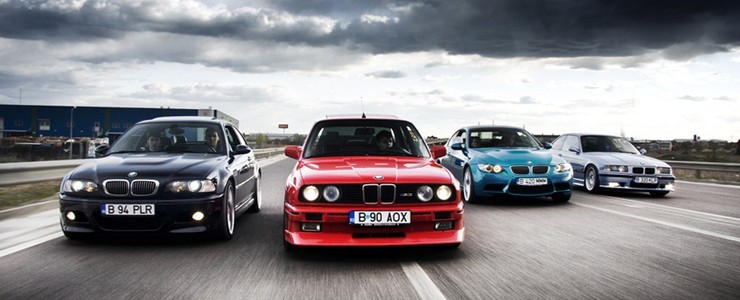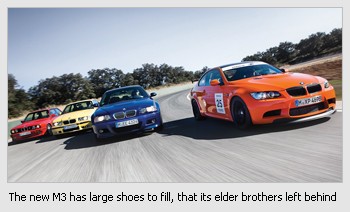BMW to drop current V8 for a more eco-friendly powertrain
05 Apr 2012|4,209 views
 The new BMW M3 seems to be getting a lot of attention especially in the powertrain department, and with good reason. The M3’s have been powered by various engine types with the first being a 2.3-litre lightweight four-cylinder. It was then followed by a 3.0-litre straight-6 and currently a 4.0-litre V8. BMW does not follow an engine template because it fits an engine that complements the M3 better.
The new BMW M3 seems to be getting a lot of attention especially in the powertrain department, and with good reason. The M3’s have been powered by various engine types with the first being a 2.3-litre lightweight four-cylinder. It was then followed by a 3.0-litre straight-6 and currently a 4.0-litre V8. BMW does not follow an engine template because it fits an engine that complements the M3 better.
In this tradition, the upcoming 2014 BMW M3 was expected to have a turbocharged inline-6 capable of reaching hundred not more than four seconds. However according to a BMW insider, something unique might be in the works. A 3.0-Litre V6. Interesting given the fact that BMW hasn’t produced a V6 before.
The heart of the new M3 is rumoured to be twin turbocharged with a possible 429hp, and 548Nm torque output. The V6 is all new and is not derived from the current V8. The new V6 will be the first to mount its turbochargers within the V-angle, a similar solution found in the company's 4.4-litre V8. This would help sharpen throttle response and minimize heat build-up. In theory, a 60-degree ‘V’ offers the best balance yet, a 90-degree angle is required to mount the two turbos. 
Over the past two and a half decades, the M3 has been synonymous with a high-revving naturally aspirated engine for the car. The next M3 will be large, yet light, thanks to alloy chassis components and increased use of ultra-high-tensile steel. Reducing weight means having a carbon honeycomb hood, titanium mufflers and carbon composite panels and seat parts. Aluminum wiring for the car's electronics replaces heavier, traditional copper, saving almost 9kg.
Other weight saving methods BMW is working on includes carbon-ceramic discs and aluminum callipers, which is likely be introduced later due to costs. M3 will tip the scales close to 1,600kg, which might include electric power steering that was not fitted to its bugger sibling the M5.
A six-speed manual will continue alongside a revised seven-speed F1 styled dual-clutch gearbox.
For the first time, the M3 will get a uniquely code named the F80 for the sedan and F82 for the coupe and convertible. Interestingly, the M3 sedan will launch before the coupe. To satisfy Gaia, the M3 has to comply with Euro 6 emissions standards and undercut both the current consumption ratings.
The M division engineers in Germany are working hard to fulfil all the above conditions and hopefully BMW can deliver a M3 true to its heritage.
The new BMW M3 seems to be getting a lot of attention especially in the powertrain department, and with good reason. The M3’s have been powered by various engine types with the first being a 2.3-litre lightweight four-cylinder. It was then followed by a 3.0-litre straight-6 and currently a 4.0-litre V8. BMW does not follow an engine template because it fits an engine that complements the M3 better.
In this tradition, the upcoming 2014 BMW M3 was expected to have a turbocharged inline-6 capable of reaching hundred not more than four seconds. However according to a BMW insider, something unique might be in the works. A 3.0-Litre V6. Interesting given the fact that BMW hasn’t produced a V6 before.
The heart of the new M3 is rumoured to be twin turbocharged with a possible 429hp, and 548Nm torque output. The V6 is all new and is not derived from the current V8. The new V6 will be the first to mount its turbochargers within the V-angle, a similar solution found in the company's 4.4-litre V8. This would help sharpen throttle response and minimize heat build-up. In theory, a 60-degree ‘V’ offers the best balance yet, a 90-degree angle is required to mount the two turbos.
Over the past two and a half decades, the M3 has been synonymous with a high-revving naturally aspirated engine for the car. The next M3 will be large, yet light, thanks to alloy chassis components and increased use of ultra-high-tensile steel. Reducing weight means having a carbon honeycomb hood, titanium mufflers and carbon composite panels and seat parts. Aluminum wiring for the car's electronics replaces heavier, traditional copper, saving almost 9kg.
Other weight saving methods BMW is working on includes carbon-ceramic discs and aluminum callipers, which is likely be introduced later due to costs. M3 will tip the scales close to 1,600kg, which might include electric power steering that was not fitted to its bugger sibling the M5.
A six-speed manual will continue alongside a revised seven-speed F1 styled dual-clutch gearbox.
For the first time, the M3 will get a uniquely code named the F80 for the sedan and F82 for the coupe and convertible. Interestingly, the M3 sedan will launch before the coupe. To satisfy Gaia, the M3 has to comply with Euro 6 emissions standards and undercut both the current consumption ratings.
The M division engineers in Germany are working hard to fulfil all the above conditions and hopefully BMW can deliver a M3 true to its heritage.
Latest COE Prices
September 2025 | 1st BIDDING
NEXT TENDER: 17 Sep 2025
CAT A$107,889
CAT B$127,501
CAT C$71,556
CAT E$127,901
View Full Results Thank You For Your Subscription.
























